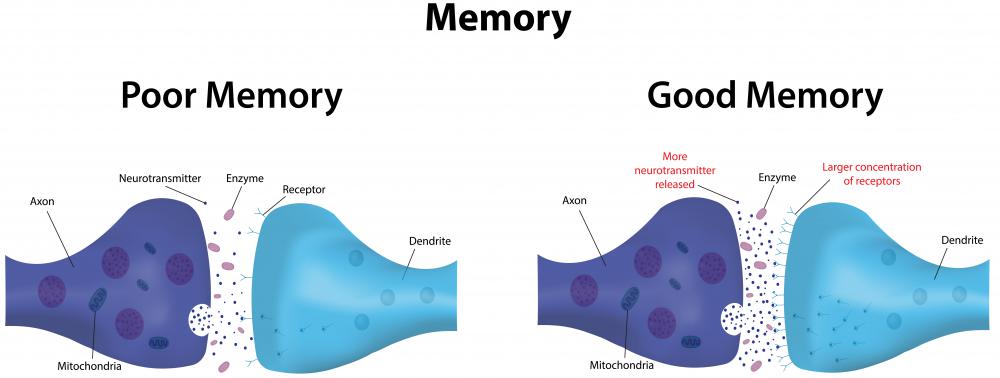At WiseGEEK, we're committed to delivering accurate, trustworthy information. Our expert-authored content is rigorously fact-checked and sourced from credible authorities. Discover how we uphold the highest standards in providing you with reliable knowledge.
What is an Adrenoceptor?
An adrenoceptor can also be called an adrenergic receptor and is one of the proteins that span along the membranes of presynaptic and postsynaptic neurons. The adrenoceptor serves as a recognition site for the binding of the neurotransmitters norepinephrine and epinephrine. There are two major classes of adrenoceptors. They are alpha- and beta-adrenoceptors.
The protective barrier surrounding a neuron is called a cell membrane, and located within it are ion channels that allow ions to move in and out of the cell. The flow of ions across the cell membrane results in a change in potential or electrical energy within the membrane. This causes a release of a chemical substance or neurotransmitter from the presynaptic neuron into the synaptic cleft, a fluid-filled gap. When the neurotransmitter is released, it binds or attaches itself to receptor sites on the postsynaptic neuron that recognize that particular neurotransmitter. Adrenoceptors are metabotropic receptors, meaning that they do not contain ion channels.

In order for associated ion channels to open and close and for ions to flow across the cell membrane of an adrenoceptor, a series of metabolic steps must occur. This involves the stimulation of G-proteins. When neurotransmitters bind to receptors, G-proteins are activated, and secondary messengers are generated. This results in enzymes being activated and the opening and closing of associated ion channels. For this reason, an adrenoceptor is also called a G-coupled receptor.
Adrenoceptors consist of two main groups: alpha-adrenergic receptors and beta-adrenergic receptors. These two groups have been further subdivided into alpha1-adrenergic receptors, alpha2-adrenergic receptors, beta1-adrenergic receptors and beta2-adrenergic receptors. These adrenoceptors bind to the neurotransmitters norepinephrine and epinephrine.
Alpha1-adrenoceptors are situated on the membrane of postsynaptic neurons. These adrenoceptors become active when norepinephrine binds to them, resulting in an activation of secondary messengers and a release of calcium. Calmodulin, a binding protein, binds with the calcium resulting in the opening of associated ion channels. This allows ions to move across the cell membrane and the neuron to become active. Alpha2-adrenoceptors are located on the presynaptic membrane of neurons, and when activated by norepinephrine, the reduce additional release of the neurotransmitter, making the neuron inactive.
Beta1-adrenoceptors are located in the heart, and when they are stimulated by transmitters, they result in an increase in heart rate and heart contraction. Beta2-adrenoceptors are found in smooth muscles. When these adrenoceptors are activated, the smooth muscles in which they are located will relax.
AS FEATURED ON:
AS FEATURED ON:











Discussion Comments
I am currently taking an alpha blocker to treat my high blood pressure. It blocks my alpha-1 receptors and causes my blood vessels to widen, so my blood can flow through them more easily.
I have a kidney condition that raises my blood pressure. My doctor put me on this medication not only to protect my heart, but also to preserve my kidney function for as long as possible.
When I first started taking it, I felt extremely lightheaded. I thought I might faint, but after the first week, my body got used to it. I'm glad I was able to continue taking the alpha blocker, because I know it is protecting my organs from damage.
I learned a little about beta-2 receptors after my daughter suffered a major asthma attack. Her doctor educated us on what actually happens when she uses an inhaler.
Her beta-2 receptors are activated when she inhales the drug used to treat asthma. The drug causes her bronchial tubes to dilate. Then, air can get through to her lungs.
When the tubes dilate, the mucus can also pass through. She can cough it up and be rid of it.
She has one inhaler for emergency situations and another bronchodilator she uses everyday to prevent episodes. Her condition has improved tremendously since she started using them, and I feel better knowing that she carries an inhaler with her everywhere she goes.
@StarJo – Blood pressure medication really can have an effect on your whole body. I started out on a low dose of beta-1 receptors, and my pressure dropped down to normal. However, I think that stress at work made it hard for the drug to work for long.
So, my doctor increased my dosage. On the lowest dose, I really didn't notice much of a difference, other than my chest no longer felt tight. When he increased the dosage, I felt a little sluggish, but it was a welcome change, because I had been wound so tight before.
He told me that as you go up in beta-1 receptor dosage, it will no longer affect only your cardiovascular system. It will start to affect other parts of your body, as well. I began to feel a bit sleepy and dizzy with the larger dose, but it still beat the alternative, so I stuck with it.
I am taking a beta-blocker to treat my high blood pressure. It works by slowing down my adrenergic nervous system. This means that my adrenalin won't pump as fast, and I won't feel panicky, because my cardiovascular system is more relaxed.
Before I started taking the medication, I often felt like something was wrong. I had an overall sense of anxiety, and my chest felt tight. Also, my heart seemed to be skipping beats.
Now, I feel much more at ease. My blood pressure is under control, and I don't feel that “fight or flight” response much anymore, unless something is actually wrong. I feel more relaxed in general, and it is so easy to fall asleep at night.
Post your comments